The million dead sardines that surfaced in Redondo Beach Harbor last week in southern California point to an ecosystem that’s sorely out of balance, tribal leaders said on March 10, as state officials tested the fish seeking a cause.
“These are serious signs that should not be reduced to ‘poor fish,’ but taken to heart because the signs are coming up the food chain,” said Caleen Sisk-Franco, Chief and Spiritual Leader of the Winnemem Wintu (McCloud River) Tribe. “Now is the time to put all that you have to pray for balance in the waters!”
She joined other tribal leaders, environmental NGO representatives and others who spouted theories on the larger factors behind the huge fish kill.
Sisk-Franco, whose tribe is fighting against the construction peripheral canal and raising of Shasta Dam, took issue with the DFG’s contention in an interview on MSNBC that “nothing appears to be out of sorts” and that the fish merely happened to swim to a place devoid of oxygen.
“Wow, science is failing to find any common connection between all these massive kills of birds, fish, and baby dolphins. But don’t worry – it is all natural,” she quipped.
State fishery biologists are conducting tests on a dozen dead sardines from the Redondo Beach Harbor in southern California to determine the cause of a massive die-off on March 8, said Andrew Hughan, Department of Fish and Game (DFG) spokesman.
Approximately one million dead sardines were discovered in the Redondo Beach harbor on Tuesday morning, raising concerns about possible water contamination among area residents, fishermen and environmentalists. The concern over increasing water pollution on the California coast highlights the alarming fact that the so-called “marine protected areas” slated to go into effect in southern California waters under Governor Arnold Schwarzenegger’s Marine Life Protection Act (MLPA) Initiative will do nothing to protect the ocean from pollution.
The Marine Life Protection Act is a landmark law signed by Governor Gray Davis in 1999. Although the law was designed to provide broad and comprehensive protection of ocean waters by creating a network of marine protected areas along the California coast, the law was eviscerated in its implementation under the Schwarzenegger. The initiative fails to protect ocean waters from water pollution, oil drilling and spills, corporate aquaculture, wave energy projects and other human impacts on the ocean other than fishing and gathering.
Hughan claimed that samples tested on-site Tuesday were clear of contamination, but California Department of Fish and Game (DFG) wardens collected about a dozen dead fish to send via overnight mail to the DFG laboratory in Rancho Cordova, where biologists will run tests to confirm that the die-off was not due to toxins in the water, according to Hughan.
“Because all the dead fish were contained in one area of the harbor, officials believe that the most likely culprit was oxygen deprivation. Recent storms could have caused the school of sardines to swim around the breakwater and into the enclosed harbor, where they were trapped and unable to get out before depleting the water of oxygen,” Hughan stated.
Biologists at the northern California laboratory expect to complete their testing by early next week, and DFG wardens will continue to monitor the harbor.
Fish kill highlights an ecosystem out of balance
Some are wondering whether the movement of fish into the harbor was spurred by a “perfect” storm of factors, including unregulated storm runoff on the southern California coast.
“It’s too early to know exactly what happened, but one theory discussed in the LA Times piece is intriguing: that the fish kill may result from a ‘perfect storm’ of factors, one of which is runoff pollution,” according to David Beckman on the Natural Resources Defense Council (NRDC) Switchboard Blog (switchboard.nrdc.org/blogs/dbeckman/). “It has long been known that urban runoff is a major and in many places growing source of water pollution in the U.S.”
“In Southern California, this is true,” he continued. “As early as 1996, work by the Southern California Coastal Water Research Project (SCCWRP) identified runoff as exceeding all other point source of pollution but one (a treatment plant which has since been upgraded).”
Although this fish kills like this are not a common occurrence, biologists say that it can happen under certain conditions. Massive die offs of anchovies have occurred in Santa Cruz Harbor in Monterey Bay several times over the past few decades.
Hughan said the city of Redondo Beach activated its crisis response team Tuesday and by noon, more than 50 volunteers were scooping fish with nets, according to Hughan. The dead fish were transported to a collection center, where they will be recycled into fertilizer. The harbor remained open throughout the day and continues to remain open.
“What we’re trying to tease apart is whether it’s a consequence of algal buildup, a fish buildup or something toxic in the water,” USC biological sciences professor David Caron told the Los Angeles Times on March 9.
© 1998 - 2011 Indian Country Today. All Rights Reserved To subscribe or visit go to: http://www.indiancountry.com
